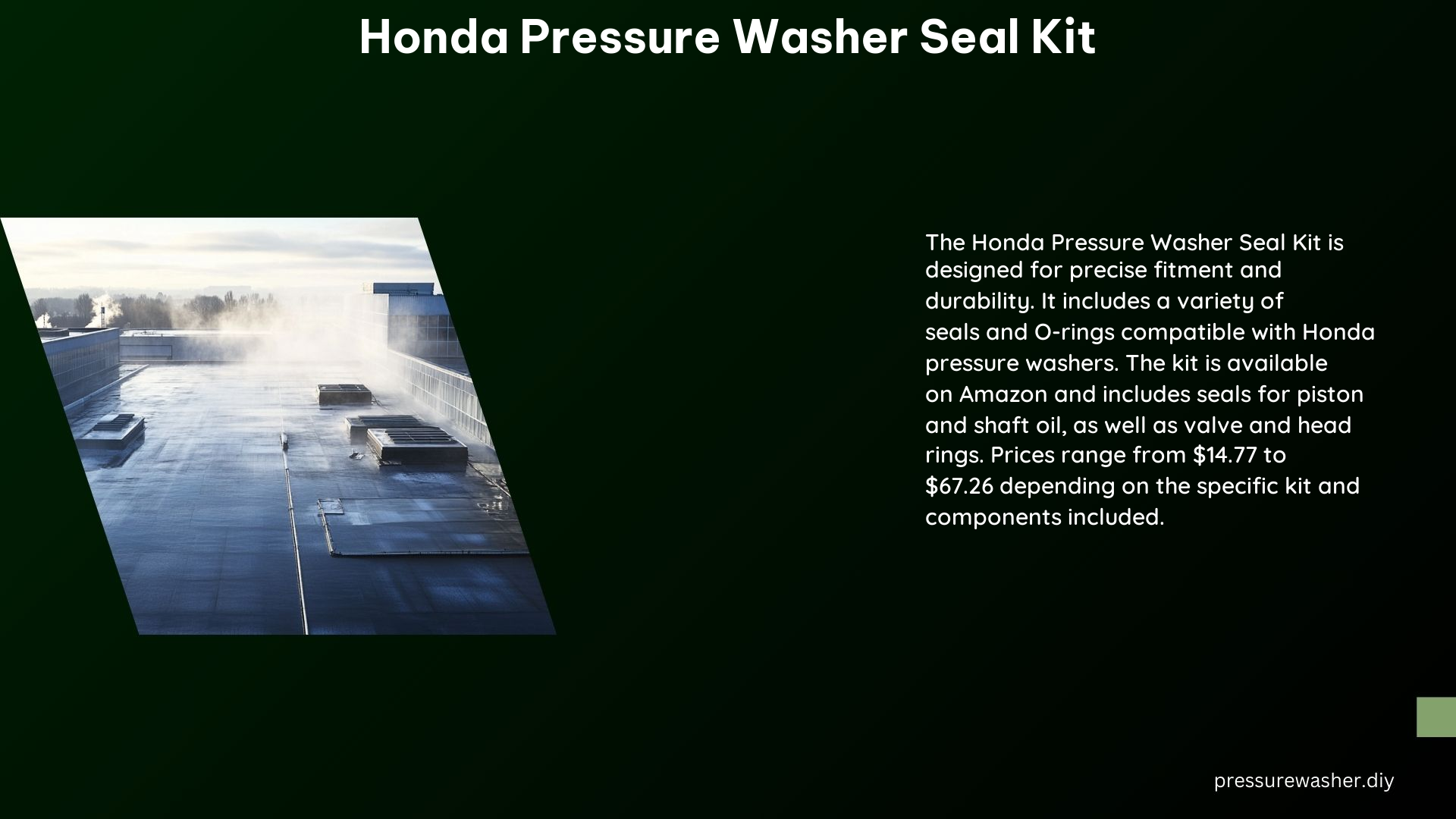The Honda Pressure Washer Seal Kit is a critical component that ensures the efficient and reliable operation of your Honda pressure washer. This comprehensive guide will provide you with in-depth information on the common signs of a faulty seal kit, the step-by-step process for diagnosing and replacing the seal kit in a Honda GCV190 pressure washer, recommended replacement parts, and the technical specifications of Honda pressure washer seal kits.
Common Signs of a Faulty Seal Kit in a Honda Pressure Washer
-
Leaks: If you notice water or oil leaking from the pump or other components, it may indicate a faulty seal kit. The seals in the kit are responsible for preventing leaks and maintaining the pressure within the system. Worn or damaged seals can lead to significant water or oil leaks, compromising the performance and efficiency of your pressure washer.
-
Reduced Pressure: If your Honda pressure washer is not producing the expected pressure, it could be due to worn-out seals. The seals play a crucial role in maintaining the appropriate pressure within the system. As the seals degrade over time, they can allow air to enter the system, resulting in a noticeable drop in pressure output.
-
Noise: Unusual noises or vibrations during the operation of your pressure washer can be an indication of seal failure. The seals help to ensure smooth and quiet operation, and any abnormal sounds or vibrations may signify that the seals are no longer functioning as intended.
-
Overheating: If the pump in your Honda pressure washer is overheating, it may be caused by a faulty seal kit. The seals help to maintain the proper lubrication and cooling within the pump, and their failure can lead to increased friction and heat buildup, potentially causing damage to the pump components.
Diagnosing and Replacing the Seal Kit in a Honda GCV190 Pressure Washer

-
Identify the Problem: Begin by carefully inspecting your Honda GCV190 pressure washer for any signs of seal failure, such as leaks, reduced pressure, unusual noises, or overheating. These symptoms will help you determine if the seal kit needs to be replaced.
-
Purchase the Correct Replacement Kit: Ensure that you purchase a seal kit that is specifically designed for your Honda GCV190 pressure washer model. Using the wrong kit can lead to compatibility issues and potential further damage to your equipment.
-
Disassemble the Pump: Follow the manufacturer’s instructions carefully to disassemble the pump and gain access to the seal kit. This may involve removing the pump housing, valves, and other components to reach the seals.
-
Remove Old Seals: Carefully remove the old seals, taking note of their orientation and placement. Clean the pump components thoroughly to ensure a proper seal with the new kit.
-
Install New Seals: Install the new seals according to the manufacturer’s instructions, ensuring that they are properly aligned and seated. Apply any recommended lubricants or sealants to the seals to enhance their performance and longevity.
-
Reassemble the Pump: Carefully reassemble the pump, following the manufacturer’s guidelines to ensure that all components are properly aligned and tightened. Once the reassembly is complete, test the pressure washer to ensure that it is operating at the expected pressure and without any leaks.
Recommended Replacement Parts for a Honda Pressure Washer Seal Kit
-
Complete Seal Kit: When replacing the seal kit in your Honda pressure washer, it is recommended to purchase a complete kit that includes all necessary seals, O-rings, and gaskets. This ensures that you replace all the critical components at once, reducing the risk of future issues.
-
OEM or OEM-Equivalent Parts: To ensure optimal performance and compatibility, it is essential to use replacement parts that are either Original Equipment Manufacturer (OEM) or OEM-equivalent. These parts are designed to meet the specific requirements of your Honda pressure washer model, providing a perfect fit and reliable operation.
-
Brass and Rubber Components: Look for seal kits that feature high-quality brass and rubber components. Brass is a durable material that can withstand the high-pressure environment of a pressure washer, while rubber seals provide the necessary flexibility and sealing properties to prevent leaks.
Technical Specifications of Honda Pressure Washer Seal Kits
-
Material: The seals in a Honda pressure washer seal kit are typically made of rubber or other durable materials, such as nitrile or Viton, which are known for their resistance to chemicals, heat, and wear.
-
Compatibility: When selecting a replacement seal kit, it is crucial to ensure that it is compatible with your specific Honda pressure washer model. The kit should be designed to fit the pump and other components of your pressure washer without any issues.
-
Components: A complete Honda pressure washer seal kit should include all the necessary seals, O-rings, gaskets, and any other components required to fully replace the existing seal kit. This ensures that you have all the parts needed to restore your pressure washer to optimal performance.
Additional Tips and Resources
-
Consult the User Manual: Before attempting to replace the seal kit in your Honda pressure washer, be sure to refer to the user manual for specific instructions and guidance. The manufacturer’s recommendations can help ensure a successful and safe replacement process.
-
Online Resources: Websites like MTM Hydro, Cam Spray, and PW Outlet offer a wide range of replacement parts and guides for Honda pressure washers, including detailed information on seal kit replacement.
-
Professional Assistance: If you are not comfortable with the seal kit replacement process or have any concerns about the condition of your pressure washer, it is recommended to consult a professional service technician. They can provide expert guidance and ensure that the job is done correctly.
By following the information provided in this comprehensive guide, you can effectively diagnose, replace, and maintain the seal kit in your Honda pressure washer, ensuring optimal performance and longevity for your equipment.
